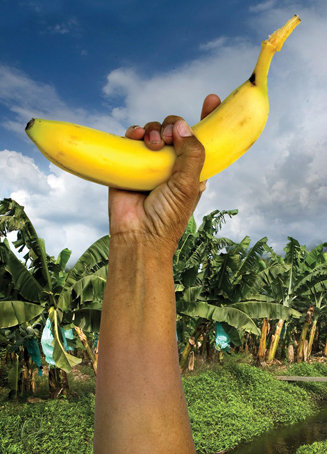Fallen Fruit
dal 15/6/2009 al 26/9/2009
Segnalato da
LACE Los Angeles Contemporary Exhibitions
15/6/2009
Fallen Fruit
Los Angeles Contemporary Exhibitions LACE, Los Angeles
United Fruit is the first solo show by the artists collective formed by David Burns, Matias Viegener and Austin Young. The installation engages its subject of banana in a range of bold and oblique strategies, signaling perhaps that no single history of the fruit is possible.

LACE is proud to present United Fruit, the first solo show by the artists collective Fallen Fruit (David Burns, Matias Viegener and Austin Young), opening Tuesday June 16, 2009 and running through September 27, 2009. This exhibition premieres a new body of work generated during Fallen Fruit's recent residency in Colombia, South America which features a series of photographs and video installations exploring the social, political and pop history of the banana.
The opening reception, on Tuesday June 16 from 8pm – 10pm, features Are You Happy to See Me?, a participatory performance involving hundreds of bananas available for eating. Attendees will be encouraged to photograph themselves playing with this often comical or suggestive fruit.
As the most popular fruit in the world, the banana is ubiquitous in daily life -- both as a food staple in grocery stores large and small as well as the supremely seductive fruit used in modern advertising and branding. At the same time the banana’s history, politics and origins have remained virtually invisible due to the remoteness of where they are grown and of the people who grow them.
Fallen Fruit's installation at LACE engages its subject in a range of bold and oblique strategies, signaling perhaps that no single history of the banana is possible. The title for the exhibition, United Fruit comes from the United Fruit Company which exists today in a much reduced form as Chiquita Bananas. More powerful than the Latin American countries it colonized, the corporation was marked by its ruthlessness and corruption, and its exploitation of workers, a turbulent history of protests and events that lead to the infamous Banana Massacre of 1928 near the town of Ciénega, Colombia, which Fallen Fruit visited to create this work. Burns, Viegener and Young chose to retain the title United Fruit for its hopeful and utopian echo, a contrast to its actual history.
The banana was first brought to Colombia over a hundred years ago by the United Fruit Company, which had a stranglehold on the global banana market, dominating all of North America and parts of Europe. They helped Latin American countries build railroads which were then utilized primarily for banana shipments, building a vast system of plantations which held workers in perpetual isolation. The economic model of the United Fruit Company became a template for a new kind of global monopoly capitalism. In the 1970s the company finally collapsed from a combination of political pressure, its own corruption, and changing economics.
The banana is a cultural symbol that has a powerful history of marketing and manipulation. In addition to its examination of the social and political history of the banana, United Fruit also examines the playful place of the banana in pop culture as the central prop in suggestive jokes and naughty humor. As much as there is a prohibition against stating the obvious, the force of the banana as a phallic symbol cannot be ignored.
The projects included in the United Fruit exhibition is part of a new long-term work-in-progress entitled The Colonial History of Fruit. This initiative combines the focus of Fallen Fruit’s work with the local or particular with the global, allowing the artists to juxtapose two kinds of history: the broad or "objective" and the anecdotal or "subjective." The history of how the fruit we eat comes from a specific place and ends up on our tables moves through specific or objective economic, historical and political forces. The "subjective" history resides in individuals and groups, the anecdotal tales of how people find new fruits, rediscover old ones, or carry along others from distant places. The next fruits to be examined are the kiwi and arctic berries.
ABOUT FALLEN FRUIT
Fallen Fruit is a collaboration between David Burns, Matias Viegener, and Austin Young. Founded in 2004, their projects range from social practice (events, performances and public actions) to photography, video and installations. Fallen Fruit deploys fruit in their work to examine social relationships, the environment, urban space and transnational capitalism. Fruit in this sense is transhistorical and crosses all classes, ages and ethnic groups. It is both ubiquitous and often invisible, yet it is also the food that appears most often in art. All of Fallen Fruit’s projects touch on, work through or work with fruit in some manner. They state that “fruit is the lens through which we look at the world. www.fallenfruit.org
Download the press release for more information on Fallen Fruit and the banana.
Fallen Fruit: United Fruit has been made possible through the generous support of the Good Works Foundation, the Andy Warhol Foundation for the Visual Arts and Side Street Projects.
The opening is sponsored by Whole Foods Market Arroyo Parkway.
Opening reception 16 June 16 2009, 8pm - 10pm
featuring the participatory performance Are You Happy To See Me?
LACE
6522 Hollywood Boulevard - Los Angeles
Wed-Sun 12-6pm, Fri 12-9pm



